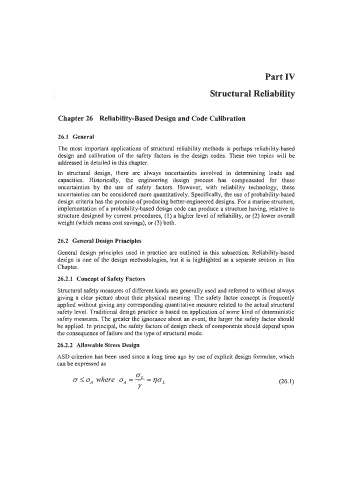Page 487 - Marine Structural Design
P. 487
Part IV
Structural Reliability
Chapter 26 Reliability-Based Design and Code Calibration
26.1 General
The most important applications of structural reliability methods is perhaps reliability-based
design and calibration of the safety factors in the design codes. These two topics will be
addressed in detailed in this chapter.
In structural design, there are always uncertainties involved in determining loads and
capacities. Historically, the engineering design process has compensated for these
uncertainties by the use of safety factors. However, with reliability technology, these
uncertainties can be considered more quantitatively. Specifically, the use of probability-based
design criteria has the promise of producing better-engineered designs. For a marine structure,
implementation of a probability-based design code can produce a structure having, relative to
structure designed by current procedures, (1) a higher level of reliability, or (2) lower overall
weight (which means cost savings), or (3) both.
26.2 General Design Principles
General design principles used in practice are outlined in this subsection. Reliability-based
design is one of the design methodologies, but it is highlighted as a separate section in this
Chapter.
26.2.1 Concept of Safety Factors
Structural safety measures of different kinds are generally used and referred to without always
giving a clear picture about their physical meaning. The safety factor concept is frequently
applied without giving any corresponding quantitative measure related to the actual structural
safety level. Traditional design practice is based on application of some kind of deterministic
safety measures. The greater the ignorance about an event, the larger the safety factor should
be applied. In principal, the safety factors of design check of components should depend upon
the consequence of failure and the type of structural mode.
26.2.2 Allowable Stress Design
ASD criterion has been used since a long time ago by use of explicit design formulae, which
can be expressed as
CL
050, where 0, =-=qoL (26.1)
Y

